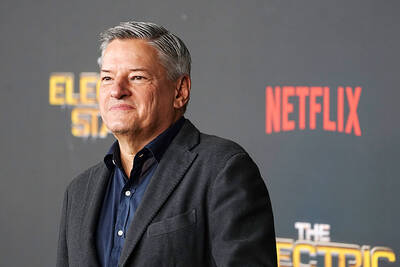Britain, a global leader in offshore wind energy, plans to make the sector one of the pillars of its transition to carbon neutrality in the next few decades.
The country aims to quadruple its offshore electricity production capacity by 2030 by utilizing the windswept North Sea and a favorable policy environment.
“It’s more conducive to build offshore in the UK than anywhere else in Europe,” said James Brabben, of the Cornwall Insight energy consultancy. “There’s quite a consensus of support around offshore wind from the public and politics.”
British Prime Minister Boris Johnson’s government pledged in its election manifesto to increase power from offshore wind from 10 gigawatts to 40 gigawatts this decade.
It wants Britain to be carbon neutral by 2050, with onshore wind, solar, hydro and biomass also to contribute to its energy mix.
The country already produces almost 40 percent of its electricity from renewable sources, according to figures published this month for the third quarter of last year.
Britain plans to favor the development of colossal offshore wind farms given the country’s relatively small land mass.
There were 38 operational sites comprising about 2,000 turbines at the end of 2018, according to the last available figures from the Crown Estate, the hereditary land and property portfolio of the royal family, which owns most of Britain’s seabed. Nearly 1,000 more turbines are already in the planning stages.
Two of the biggest projects are Walney Extension, in north Wales, and London Array, at the mouth of the River Thames.
The two sites are home to the highest concentration of British offshore farms, thanks to the windy weather conditions created by their geography.
Several other projects are also under way, including at Hornsea and Dogger Bank off Yorkshire, which will compete for the title of largest offshore wind turbine field in the world.
Johnson has also touted rolling out floating wind farms, which utilize cutting-edge technology still being developed, to tap into windy marine areas with deeper seabeds.
Maritime wind farms have not proved universally popular among residents when visible from the shore, while some non-governmental organizations have concerns over the impact on marine mammals and migratory birds.
The sector is also trying to account for the so-called “global cost” to the planet of building and running wind turbines.
Danish manufacturer Vestas has estimated it takes between five and 12 months of use to offset the energy cost of a turbine, the difference depending on the model and wind conditions.
“As turbines repay their entire carbon footprint in such a short space of time, they are excellent examples of sustainable technology in action,” RenewableUK industry trade association head of communications Robert Norris said.
Alastair Dutton, who heads a task force at the Global Wind Energy Council industry group, said that bigger investment in technological innovation is needed “to further increase their sustainability.”
That would allow turbine producers to “move away from carbon-intensive raw earth materials and implement the highest level possible of recycling to insert wind within the circular economy,” Dutton said.
Offshore wind power had a record year last year, with the completion of projects off Taiwan, Britain, China and the Netherlands, among others.
The International Energy Agency has highlighted the almost “unlimited potential” of offshore wind power, as production costs fall and technological progress increases turbines’ power and efficiency.

The demise of the coal industry left the US’ Appalachian region in tatters, with lost jobs, spoiled water and countless kilometers of abandoned underground mines. Now entrepreneurs are eyeing the rural region with ambitious visions to rebuild its economy by converting old mines into solar power systems and data centers that could help fuel the increasing power demands of the artificial intelligence (AI) boom. One such project is underway by a non-profit team calling itself Energy DELTA (Discovery, Education, Learning and Technology Accelerator) Lab, which is looking to develop energy sources on about 26,305 hectares of old coal land in

Taiwan’s exports soared 56 percent year-on-year to an all-time high of US$64.05 billion last month, propelled by surging global demand for artificial intelligence (AI), high-performance computing and cloud service infrastructure, the Ministry of Finance said yesterday. Department of Statistics Director-General Beatrice Tsai (蔡美娜) called the figure an unexpected upside surprise, citing a wave of technology orders from overseas customers alongside the usual year-end shopping season for technology products. Growth is likely to remain strong this month, she said, projecting a 40 percent to 45 percent expansion on an annual basis. The outperformance could prompt the Directorate-General of Budget, Accounting and

Netflix on Friday faced fierce criticism over its blockbuster deal to acquire Warner Bros Discovery. The streaming giant is already viewed as a pariah in some Hollywood circles, largely due to its reluctance to release content in theaters and its disruption of traditional industry practices. As Netflix emerged as the likely winning bidder for Warner Bros — the studio behind Casablanca, the Harry Potter movies and Friends — Hollywood’s elite launched an aggressive campaign against the acquisition. Titanic director James Cameron called the buyout a “disaster,” while a group of prominent producers are lobbying US Congress to oppose the deal,

Two Chinese chipmakers are attracting strong retail investor demand, buoyed by industry peer Moore Threads Technology Co’s (摩爾線程) stellar debut. The retail portion of MetaX Integrated Circuits (Shanghai) Co’s (上海沐曦) upcoming initial public offering (IPO) was 2,986 times oversubscribed on Friday, according to a filing. Meanwhile, Beijing Onmicro Electronics Co (北京昂瑞微), which makes radio frequency chips, was 2,899 times oversubscribed on Friday, its filing showed. The bids coincided with Moore Threads’ trading debut, which surged 425 percent on Friday after raising 8 billion yuan (US$1.13 billion) on bets that the company could emerge as a viable local competitor to Nvidia